If you list the symptoms of cervical osteochondosis - almost all adults will say that it has felt them.This disease really has a significant prevalence: in developed countries, osteochondrosis occurs in 60 to 80% of the population.In order to distinguish if a person really has cervical osteochondosis or is it manifestations of a different state, it is necessary to have information on this pathology.The article describes the causes of the disease, its characteristics and manifestations, diagnostic and treatment methods.Having information on pathology, patients will be able to recognize it at home and ask for help in a timely time.
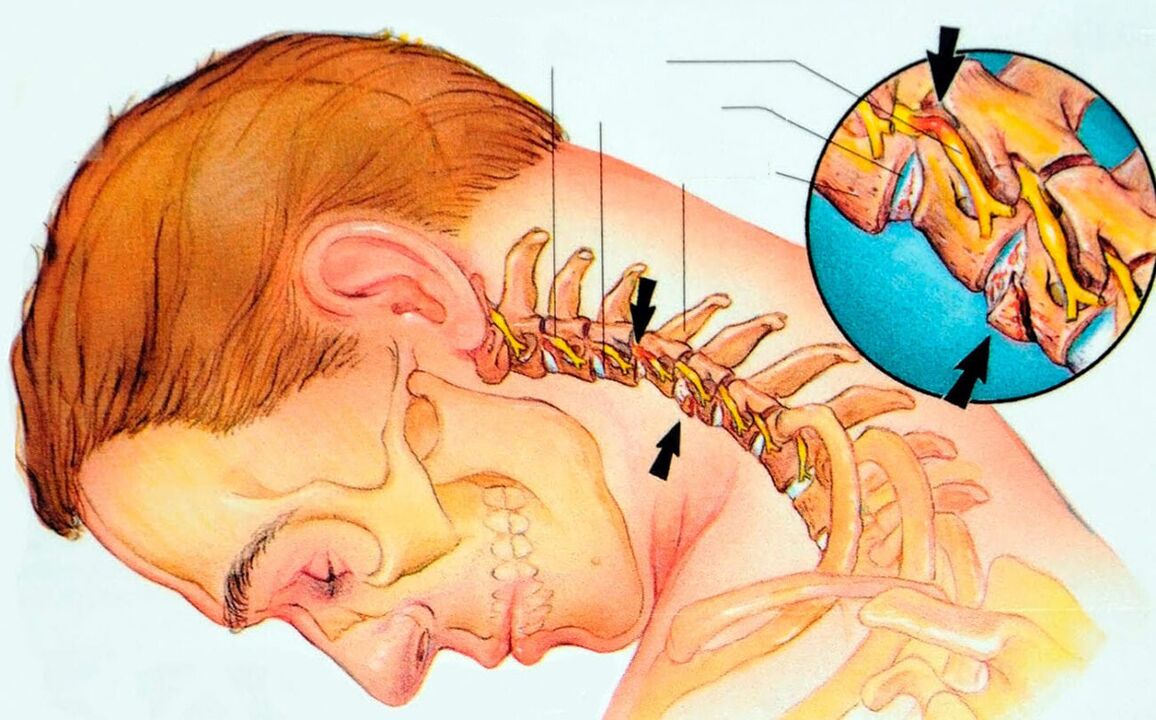
What is cervical osteochondosis?
The disease is degenerative in nature and damages the structure of the spine with the primary and secondary mechanism.The pathogenetic mechanism of pathology is that the structure of the vertebral connection is damaged.
Normally, between these areas, there is a layer - a pulpoose tissue.It depreciates the spine and optimizes the engine process.With cervical osteochondosis, this soft substance is calcified and turns into hard ochier fabric.This damages nerve endings and blood vessels, violating their function.
Depending on the level of damage, osteochondrosis can manifest itself by pain or high pressure, altered consciousness or numbness of the language.These can be symptoms of the chest or back.This considerably complicates the diagnostic process.Patients can take several diagnostic consultations before going to a profile specialist.The diagnostic process uses several methods that allow the exclusion of the pathology of other organs and systems.
Gradually, cervical osteochondosis "becoming younger" and is increasingly found in young patients.Modern young people are starting to encounter problems with the neck much earlier than their parents.
Osteochondrosis is degeneration of the cervical region, which is usual to consider from two positions:
- Physiological changes.Indeed, degeneration of cartilage is a natural element of development, which is regulated by neuro-Endocrinian mechanisms and is irreversible.The process begins with the center of the luscious layer and gradually passes to the periphery.The soft fabrics are replaced by fibrous fibrous elements.Such a process practically does not disturb the patient and only manifests itself when it affects nerve endings.
- Pathological changes.Destruction of the vertebrae following the effect of a set of factors.This process is ahead of physiological changes and leads to a violation of the spine function.Symptoms almost always accompany this condition, because they spread outside the cartilage structure and damage nerve endings, blood vessels.
The course of the disease can be of a different nature: sometimes the pathology is offset independently or vice versa - there are periods of exacerbations.Simultaneously with the pathological process, compensation mechanisms are included, which temporarily extends the function of the vertebrae and eliminates the symptoms.
However, the additional course of the disease leads to the destruction of the fibrous ring, the appearance of microfissuries.The vertebrae lose their stability and their fixation, which manifests itself in a clinical picture of the disease.
In addition, cervical osteochondosis is the impregnation of the pulp of the intervertebral space with calcium.This forms a kind of hernia, because the damaged vertebra is pressed in the neighbor's body.These structures wear out and, therefore, there is a massive ossification of neighboring structures.
The course of cervical osteochondrosis has several stages:
- Step 1 is the instability of the violation of vertebral structures and discs;
- 2 steps - reduced fixing of the spine and protruding of the disc;
- Stage 3 - Rupture of a fibrous ring, serious symptoms and pain;
- The 4th stage is accompanied by moving difficulties, acute pain and generalized bone propagation.
The characteristics of the anatomical arrangement of the muscles and blood vessels - make the neck a vulnerable area of the body.A long course of osteochondrosis leads to many complications, including vascular nature.Many of them can harm the patient's health and constitute a pronounced risk.
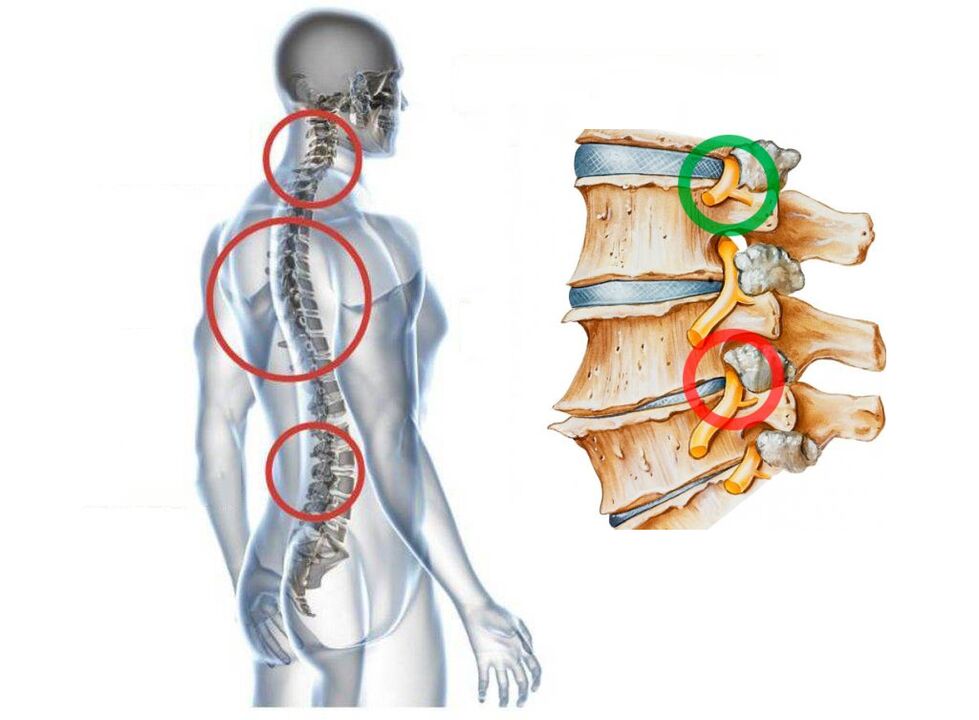
Symptoms
The danger of cervical osteochondosis is that it has not been manifested for a long time by symptoms.This is facilitated by masking signs of the disease for another pathology, as well as an independent administration of analgesic drugs.This makes the diagnosis of long and difficult cervical osteochondosis.It is important not to delay the diagnosis as long as the structure of the vertebrae has been replaced by the bone tissue.
Consider the main groups of symptoms found in osteochondrosis in the cervical region and their characteristics.
Dizziness
As mentioned above, most symptoms of osteochondrosis may be characteristic of other conditions.Thus, dizziness is accompanied by vascular pathologies of the central nervous system, hearing aid damage, dysfunctions of the vestibular apparatus and cardiovascular disease.Dizzying is accompanied by poisoning and inflammatory processes.It is important to take into account a holistic clinical image and not individual symptoms.You also have to learn to distinguish the main types of dizziness for reasons of its occurrence.
With osteochondrosis of the cervical column, a systematic type of dizziness occurs.It seems to the patient that surrounding objects are starting to be in motion.Such a disorder can be observed after a head and neck injury, as well as in the bottom of the vestibular apparatus diseases.
Headache
Again, it is extremely difficult to call this specific symptom.The pain in the head can accompany overwork, increased pressure, as well as serious acute conditions.With osteochondrosis, headaches occur following the compression of nerve endings.This leads to spasms of the arteries that suspend the brain, as well as to increase the pressure in the central nervous system system.The result is a feeling of pronounced headache.
The characteristics of headaches in this case are a dull character and a feeling of pulsation.Sometimes pain can manifest with attacks and sometimes has a constant character.Pain parameters for osteochondrosis resemble the characteristics of this with hypertension, angina.The differences in headache in cardiological pathology are that it is accompanied by chest pain, heart rate, changes in ECG.Therefore, only a doctor can finally determine the cause of pain.
Pain syndrome of various localization
In addition to the headache, the patient is often concerned about pain in the neck.This is called a cervical and a complication of osteochondrosis.Painful sensations can radiate towards the upper limb.Patients note that pain in their hands occurs after awakening, in the context of sudden movements.Painful sensations pass from themselves after a short rest.
The characteristics of cervical osteochondosis pain syndrome are listed below:
- Unpleasant sensations are located in the deep tissues of the neck;
- The turns of the head are often accompanied by pain and crunch;
- There is muscle weakness, numbness, cooling of the hands.
Most often, neck osteochondosis affects two lower vertebrae - 6 and 7. For a small self -diagnosis, this method is recommended.It is necessary to pay attention to the combination of pain in the neck and fingers of the hand.Most often, if the 6th vertebra is affected, the pain will be felt in the thumb and changes in the 7th vertebra are accompanied by discomfort in the middle finger.
Blood pressure changes
Such a symptom appears when nerve endings and blood vessels are affected by changes in vertebrae.How to distinguish this phenomenon from hypertension?First of all, hypertension for cervical osteochondosis is not constant and has its own jumps in one day.
Osteochondrosis consists of the following syndromes:
- Vertebral.It is also called vertebra, which indicates that the bones and tissues of the cartilage are involved in the pathological process.This leads to the formation of such symptoms: restriction of the motor activity of the neck, pain in its turns, radiological changes in the image of the cervical column.It is the simultaneous appearance of these signs which is a vertebral syndrome.
- Vertebral artery syndrome.It appears when the vascular beams are involved in the process, which are responsible for the blood supply to the tissues of the central nervous system.Symptoms suggest that brain tissues have ceased to receive a good amount of nutrients.How to recognize this syndrome?The first signs are dizziness, a feeling of noise in the ears, the differences in blood pressure, the appearance of a "veil" in front of the eyes.This suggests that one of the vertebrates is in a strangled state.Each ship has its own nerve endings.If you tighten those who innervate the vertebral artery - migraine, numbness, short -term decrease in the vision on the one hand appears.As a result, changes in the ship lead to the fact that the brain needs oxygen.Currently, a person feels drowsiness, short -term violations of consciousness, loses attention and control, works worse and remembers information.With such a clinical image, it is necessary to differentiate cervical osteochondosis with the atherosclerosis of the vertebral arteries and to tighten the tumor or inflammation.
- Cardial syndrome.It manifests itself by burning in the chest, the appearance of shortness of breath.A person feels their frequent heart rate becomes tired and irritable.This image is also characteristic of cardiological pathology, for example, for angina, coronary syndrome, heart attack.The exact conclusion on the causes of these symptoms can be made after the patient passes the ECG.
- Rook syndrome.The Cervical Department Innerve 8 pairs of nerves, each with roots - the place of exit of the nerve of the vertebra.When involved in osteochondrosis, the patient feels a decrease in sensitivity or vice versa - severe pain.There may be a numbness to find out if your pain, a decrease in the sensitivity of the language, the freezing area, pain in the Superraclinking region can be observed.Sometimes there are swallowing disorders, movements in the upper limb belt, numbness of the fingers.
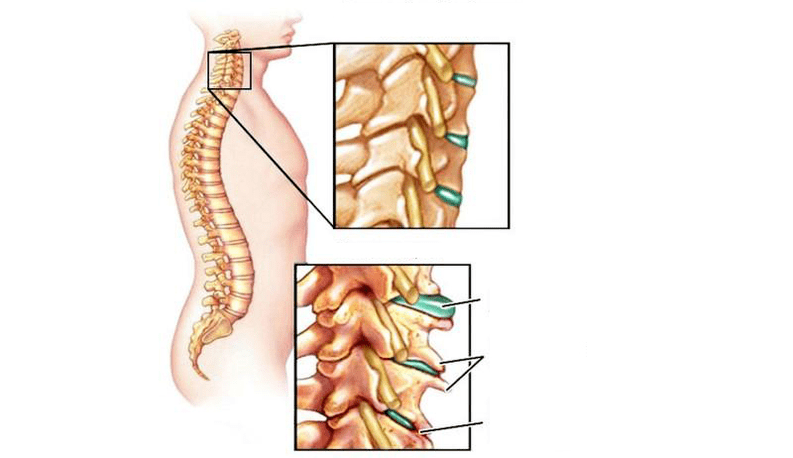
The causes of cervical osteochondosis
The main reason for the development of osteochondrosis is the incorrect distribution of the load on the spine.The reasons may be different - a person can carry a bag or a weight in one hand, takes an incorrect pose when he sits or sleeps on an uneven surface.It increases the load and a high pillow and shoes that do not correspond to the anatomical characteristics of the foot.Such reasons may seem insignificant, but they act for a long time and, therefore, lead to a logical consequence in the form of osteochondosis.
Among the risk factors that increase the possibility of the occurrence of the disease:
- low level of physical activity;
- increase in body weight;
- vertebral injuries transmitted;
- violation of the posture or the pathology of the foot;
- Blood supply reduced to the cervical column.
All this leads to the fact that the bad position of the vertebrae is formed.The weight is not distributed to all sections of the cervical region uniformly and some of its departments have heavy loads.The answer is a change of tissues.
To one degree or another, the situation can be aggravated:
- Underwent a serious illness or an injury which led to an exhausted state of health;
- Frequent constraints;
- Violation of metabolism in the body, reduction of the consumption of trace elements, their increased consumption or the lack of absorption in the intestine;
- Occupational diseases (in particular vibrational diseases);
- Hereditary tendency to osteochondrosis;
- Scoliosis and other disorders of the musculoskeletal system;
- Violation of the consumer regime;
- Low quality nutrition and bad habits;
- Pregnancy.
As you can see, there is no cause of osteochondosis.There are only one set of factors that can cause it.Again, the same reason affects different people in different ways.The state of health, duration, intensity and the number of risk factors, substantive pathologies and lifestyle plays a role.
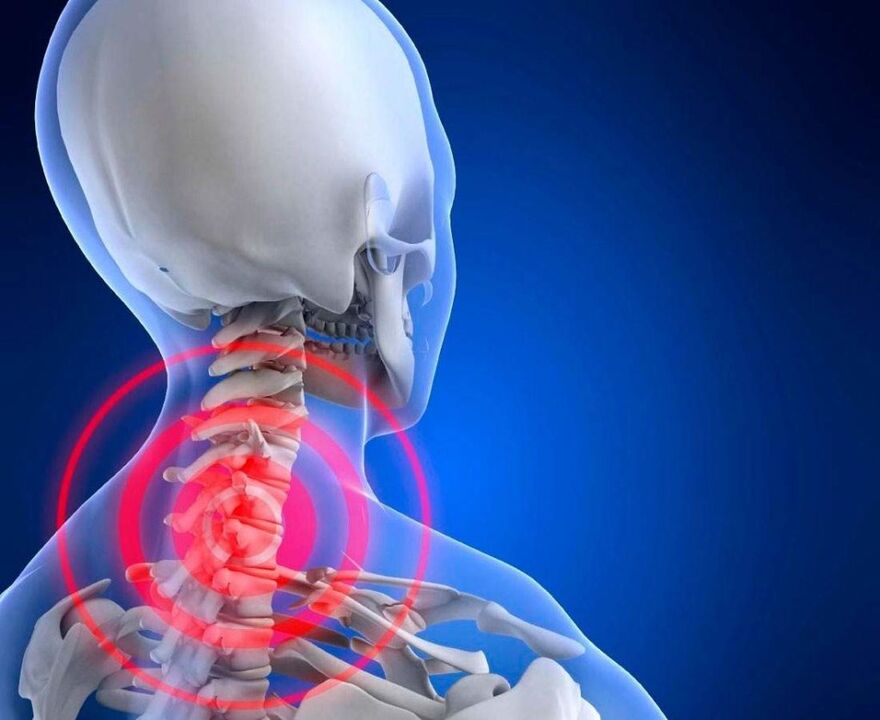
Modern treatment methods
Even before the prescription of therapy, the patient must modify the lifestyle.For this, it is necessary to modify the level of charges that the cervical service experiences.It is necessary to monitor the quality of nutrition, to allocate the time necessary for sleep and rest, to be wary of stress.If the body has a background pathology which exacerbates the course of osteochondrosis, it is necessary to undergo a treatment course and eliminate it.The choice of the treatment method depends on the stage of osteochondrosis and the well-being of the patient.
Treatment can be:
- Non-Drug;
- medicine;
- Surgical.
In addition, also consider folk methods and rehabilitation measures.
Non -drug treatment methods are to use therapeutic exercises, simulators or special devices, manual therapy, as well as physiotherapeutic methods.An appropriate objective is facilitated by improving blood supply in the vertebrae or slowing down the ossification process.
As for manual therapy or massage, be sure to consult a doctor about their opportunity.Do not independently assign these methods.At certain stages of osteochondrosis, massage can only harm and cause long immobilization.If manual therapy is carried out according to the indications, it is able to relieve symptoms and improve the well-being of the patient.
Physiotherapeutic techniques, with cervical osteochondosis, the following elements are used:
- magnetotherapy;
- Therapeutic baths;
- Therapeutic shower;
- mud;
- Electrophoresis.
The use of drugs is indicated in the event of exacerbation of the situation.Many of them eliminate inflammation and acute pain, improve the blood supply of tissues, restore the structures of cartilage and ensure joint mobility.This is a complete approach to causes and symptoms, not a unilateral solution to the problem.After taking properly selected medication, the patient has the opportunity to move his neck again, stops feeling irritation, aggravating mood, returning to normal work and sleep.
Consider the groups of drugs used for cervical osteochondosis:
Non-steroidal anti-inflammatory drugs
They are used to reduce inflammatory phenomena in the tissues, eliminate pain, relieve roots and blood vessels.With minor symptoms, ointments and gels are used, more intense pain syndrome is stopped by tablets of tablets.The injection administration is prescribed with a severe intensity of pain and its strong occurrence.
They may have other commercial names, but the active substance remains unchanged.The patient must take medication with the course, only after approval of the attending physician.Please note that these funds should be taken after eating, as they can irritate the lining of the gastrointestinal tract.
Vasodilators
Their function is the expansion of the vessels which are reduced in the context of the course of osteochondosis.Medicines - Pentoxifillin, Actgin, Berlshion.These drugs will relieve the vertebral artery syndrome, will improve blood flow to the vertebrae and the patient's well-being.It is necessary to monitor the lack of contraindications of these substances in the patient, as well as their compatibility with other drugs that a person takes.
Muscle relaxing
The goal of this group is a decrease in the spasm of the neck muscles.This accelerates and optimizes the processing process, as muscle tension acts on ships and nerve endings.Regular intake normalizes the tone of blood vessels reduces the feeling of pain.
Chondroprotector
Take to improve the condition of the elements of the cartilage of the spine and to protect their structure from destruction.A long reception of these substances is necessary, otherwise they will not have the right action.Patients may not like the effect only after 6 months of use.However, if this effect is obtained, it will be persistent and considerably improve the clinical picture.
Sedatives
They are used as auxiliary substance in order to eliminate depressive manifestations and stress.In soft cases, Valerian, promises, mint and lemon balm are used.If depression is progressing, more serious substances are necessary.They will improve sleep and mood, will help the patient connect to effective treatment.
Vitamins
The reception of group B vitamins. They can be recommended from food - this vitamin introduction route is the most physiological and does not carry a special load on the liver.If vitamin deficiency is observed, vitamin complexes and drugs can be used.This will improve sensitivity and innervation, will accelerate the tissue restoration process.
Since the processing process is prolonged and gradually brings the effect, all stages of taking medication are significant.Make sure drugs are stored in the right place, as shown in the packaging.If on the box, it is written that you should store medication in a dark or cool place - do it, otherwise the drug will lose its properties.Observe the duration of the course and the frequency of the application - certain substances tend to accumulate in the body, and it is only the right effect.
If the introductory path is injectable, the procedure must be carried out by medical staff or a trained person, because the correct introduction increases efficiency.Tabblet forms must be taken after meals, washed with water.Be careful at this time, because other liquids are not suitable for this.The combination of grapefruit juice and medication is particularly dangerous - the enzymes contained in this fruit slow down liver function and reduce the delivery of tissue medicines.
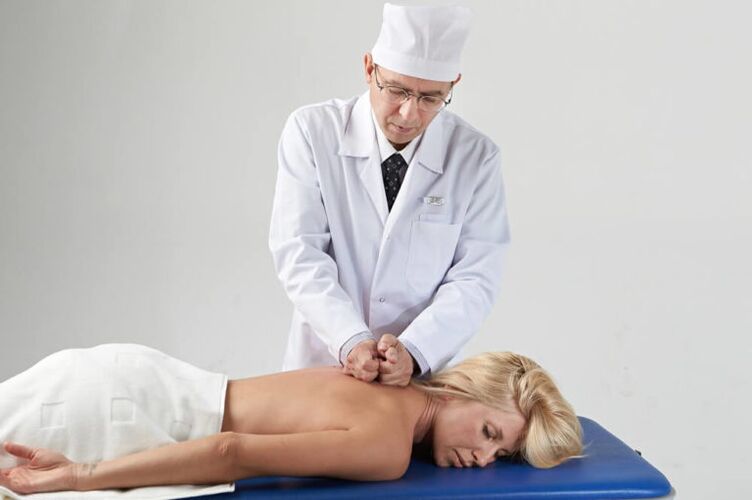
Surgical treatment of cervical osteochondosis
This method is used when cervical osteochondosis has led to the narrowing of the light spine.This can happen as a result of a hernia or a protruding from the disc.The narrowing of the canal is accompanied by a significant stenosis of the vessels and a compression of the nerve beings.If an isolated hernia of the intervertebral discs is observed, this also indicates surgery.The operation is necessary for spondylolistz - a displacement of the vertebrae of the axis.In addition to these indications, the doctor pays attention to the quality of the patient's life, his condition, the severity of the symptoms.
Types of surgical interventions:
- Supported spondylodeza.Essence consists in eliminating the damaged disc and replacing it with a mobile connection, a prosthesis which fulfills the function of a remote structure;
- Dynamic stabilization of the spine.A silicone implant is introduced between the rotation processes along the spine, which correctly distributes the load and stabilizes the vertebrae;
- Vaporization of the disk nucleus with a laser beam.It is a modern technique that shows good results.The laser affects the core of the disc, reducing its size and eliminating the hernia.The intervention is atravatic, it can be carried out under local anesthesia.However, a set of indications for such manipulation is limited, this can only be done at this stage.When a hernia size does not exceed 6 mm.This focuses again on the reasons why the early research of a doctor and a timely diagnosis are useful.
Surgical interventions take place in a hospital.Depending on the degree of complexity of treatment, the duration of the postoperative period and rehabilitation differs.Driving surgery involves an additional medication complex - drug preparation, pain relievers, antibacterial therapy for the prevention of septic complications.
Diagnosis
The start of the diagnosis is the start of the patient's address to the doctor and the list of symptoms.The doctor listens to the patient's complaints, details them, form from syndromes symptoms.In addition, the specialist needs details on clinical manifestations: time of occurrence, if the treatment methods have been used and what influence, the nature of the pain, increased pressure periods and others have been used.In important information, there is information on an uncomfortable position during sleep, work, bad habits, background disease.All this is clear during the conversation.
X -Ray is carried out in direct and lateral projections.A functional radiological study is carried out simultaneously with the rotation of the neck.The contrast of the vertebral canal is used in order to better visualize the affected areas.The contrast can be introduced into the vessel or the disc itself, depending on the method called angiography or discography.In the image, you can see the fabric joints, calcification deposits, moving the structures of the spine.
As for magnetic resonance tomography, it is the most informative method, which is also painless and fast.The doctor can see damage and establish the severity of the process.Tomographer's scans will help the surgeon prepare for the operation, determine hernia, changes in nerve endings and blood vessels.
MRI is carried out in the absence of contraindications which are metallic objects in the body, claustrophobia.pregnancy.
Computed tomography also gives a precise diagnostic image.The study does not take much time - about 10 minutes and does not require special preparation.The radiation burden in this study is small, which makes Health Tomography.Contraindications - pregnancy and lactation, age of children.
In addition to the methods that allow you to visualize the pathological process, it is necessary to use additional diagnostic manipulations.
These include an ultrasound study of the head and neck vessels.Diagnostic indications are dizziness, headache, pressure drops.The specialist will determine the permeability of blood vessels and the state of blood circulation.The most informative method, in this case, is a duplex scanning of the blood vessels.
Prevention
As you can see, cervical osteochondosis has a diversified clinic, many syndromes and requires a serious approach both in diagnosis and treatment.If you pay attention to your sensations, listen to the body and respond to its signals, an early diagnosis is possible.In the early stages of the disease - treatment has a high effect.
To do this, contact a profile specialist and browse the necessary search methods.A high quality and a timely treatment will avoid complications, will improve the behavior and quality of life, will eliminate depression and normalize sleep.Connect yourself in a positive way and you can again feel freedom of movement.





































